Fifth Annual Oxygen Market Analysis
Round Two Leaves Unsure Future
Oxygen providers sound off about Round Two of competitive bidding, portable oxygen and treatment methods in our annual oxygen survey.
- By Joseph Duffy
- Aug 01, 2013
 Respondents answered Respiratory & Sleep Management’s 2013 annual oxygen market analysis survey questions after learning whether they won their bids for Round Two of competitive bidding. And there’s been a lot to contemplate: Those who didn’t win must try to run their business successfully without a contract, while the industry learns that a significant number of successful bidders are lacking the required licensure or accreditation for the specific states in which they won contracts. To add more scrambling to the mix, a new bill calls for a six-month delay to the implementation of Round Two, as well as the Round One re-compete.
Respondents answered Respiratory & Sleep Management’s 2013 annual oxygen market analysis survey questions after learning whether they won their bids for Round Two of competitive bidding. And there’s been a lot to contemplate: Those who didn’t win must try to run their business successfully without a contract, while the industry learns that a significant number of successful bidders are lacking the required licensure or accreditation for the specific states in which they won contracts. To add more scrambling to the mix, a new bill calls for a six-month delay to the implementation of Round Two, as well as the Round One re-compete.
One dubious respondent to our fifth annual survey said that when it’s all worked out, “oxygen patients will no longer be looked at as being a profitable customer in most cases.”
But that certainly isn’t the case yet. About 66.9 percent of respondents, up from last year’s 61.2 percent, said that their oxygen business has grown in the past 12 months, with many respondents (39 percent) experiencing growth between 6 percent and 10 percent. And those not considering to leave the HME industry in 2014 due to competitive bidding, the 36-month oxygen cap and other Medicare caps was 57.3 percent, slightly down from last year’s 59 percent. Other survey highlights include:
- 27.1 percent of respondents named pre- and postpayment audits as the greatest challenge to their oxygen business. Last year, 32.4 percent said the 36-month oxygen cap created the greatest challenge in the past 12 months. This year, the cap was named by 24.8 percent of respondents.
- 85 percent of respondents in Round Two of competitive bidding bid on oxygen services, with less than half receiving a contract.
- 45.8 percent of bid winners expect their oxygen contracts to expand their business 21 percent to 40 percent.
Round Two of Competitive Bidding
About 45.2 percent of survey takers participated in Round Two of competitive bidding. From that 45.2
percent, 85 percent bid on oxygen services and 48.1 percent accepted a Round Two contract from CMS for oxygen services. Bid-winning respondents received oxygen contracts, on average, for five CBAs, with respondents ranging from wining bids in one CBA to 33 CBAs.
Surprisingly, 29.2 percent of winning bidders do not have a location in all the CBAs in which they were awarded oxygen services contracts. And only one out of all the winning bidders said it didn’t have all statespecific licenses, certifications or accreditations for the CBAs for which it was awarded a contract. The majority of bid winners (79.2 percent) do not plan to subcontract services for any of the CBAs in which they hold a contract for oxygen services.

The majority of bid winners said that their Round Two contracts for oxygen services would expand their business:
- 45.8 percent of respondents said business will expand 21 percent to 40 percent.
- 45.8 percent said business will expand up to 2 percent
- 4.2 percent said their business will expand 61 percent to 80 percent.
In comparison, bidders who weren’t awarded a Round Two contract in oxygen services or refused an oxygen services contract, do feel this will have an impact on their revenue. About 37.5 percent of respondents said that their oxygen business could see revenues impacted up to 20 percent, while 29.2 percent of respondents said their business expects a 21 percent to 40 percent loss. The loss of oxygen services by not winning a bid has forced 41.7 percent of non-winning respondents to seriously consider selling their business. For bidders looking to diminish the impact of losing oxygen services in their CBAs, they plan to:
- Increase referrals from private payor insurance carriers (50 percent).
- Increase retail sales (50 percent).
- Subcontract (37.5 percent).
One respondent commented, “Round Two of competitive bidding has compromised every oxygen users access to portability.”
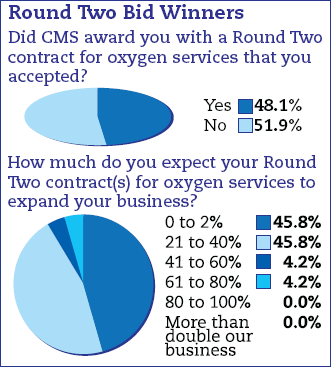
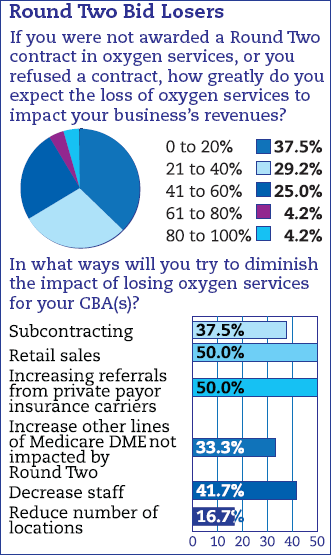
Oxygen Business
The primary jobs of respondents included respiratory HME business owners (42.8 percent), respiratory services managers (35 percent), respiratory therapists at a home care company (21.1 percent) and respiratory therapist at a hospital (1.1 percent). Just under 76 percent of respondents have a program to service traveling oxygen patients. Respondents’ business models include a mixture of equipment options with emphasis on transfilling systems and/or POCs (29.6 percent), stationary concentrators and oxygen cylinder delivery only (26.1 percent) and transfilling systems and/or POCs only (9.9 percent).
“Portable oxygen concentrators are the new craze for all oxygen patients,” said one survey taker. “The cost is still outrageous and the reimbursement is terrible. Companies are pushing portable O2 to gain clients, but are not informing patients that most portable O2 concentrators are pulse dose and some of these patients cannot tolerate a conserver, not to mention a pulse dose portable oxygen concentrator. I feel the commercials and the flyers that I have seen for portable oxygen concentrators are very misleading to chronic patients. Everyone wants freedom, but at what price are we going to sacrifice the patient’s well being?
Aside from the Round One of competitive bidding and other roadblocks and distractions, 66.9 percent of oxygen industry respondents reported oxygen business growth in the past 12 months. Last year, 61.2 percent of respondents said their business grew over the last 12 months, which was slightly lower than the previous year (63.4 percent).
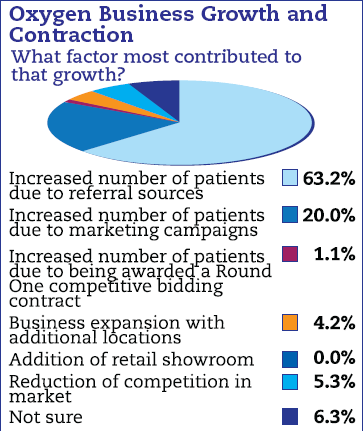
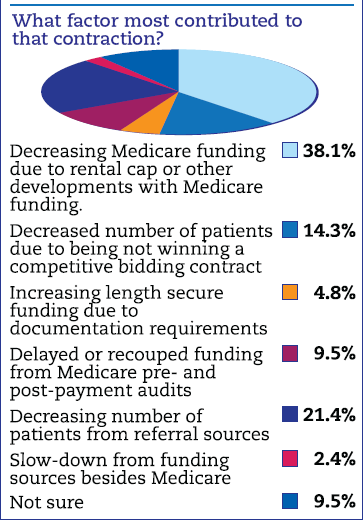
Just over 39 percent of respondents said their oxygen business had growth that ranged from 6 percent to 10 percent. Only 1 percent had significant growth at more than 40 percent while 16.5 percent reported growth that was less than 5 percent. The factors that most contributed to growth included:
- Increased number of patients due to referral sources (63.2 percent).
- Increased number of patients due to marketing campaigns (20 percent).
- Not sure (6.3 percent).
Respondents also mentioned that closing businesses and DASH COPD programs contributed to growth.
For those respondents that didn’t see business growth, 33.3 percent said they contracted less than 5 percent, while 19 percent said they contracted 16 percent to 25 percent. Reasons behind this contraction?
- 38.1 percent of respondents said decreasing Medicare funding due to rental cap or other developments with Medicare funding
- 21.4 percent said decreasing number of patients from referral sources
- 14.3 percent said decreased number of patients due to not winning a competitive bidding contract
Other factors that respondents included were loss of major insurance carrier, not aggressively marketing oxygen and lack of documentation from physicians to renew patient’s oxygen.
Last year, 32.4 percent of respondents said the 36-month oxygen cap was their biggest oxygen business challenge over the previous 12 months. In fact, that was third time in a row in the Respiratory & Sleep Management annual oxygen survey that the 36-month oxygen cap was named the biggest oxygen services challenge. This year, 27.1 percent of respondents said pre- and post-payment audits was the biggest challenge for their oxygen business over the last 12 months. The 36-month oxygen cap dropped to second place with 24.8 percent of respondents. Round Two of competitive bidding was third with 20.9 percent of respondents. Respondents also named poor physician documentation as a major challenge encountered in the last 12 months.
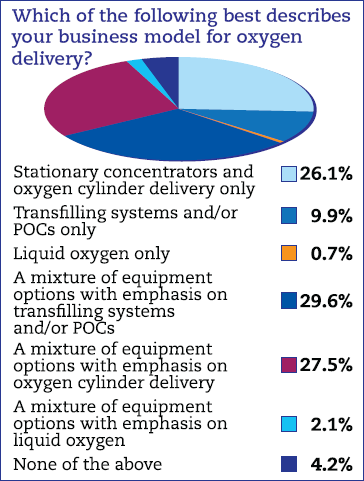
With the 36-month rental cap now in place for three years, respondents were asked to describe its current impact on their business. Responses included moderate (58.5 percent), heavy (28.5 percent) and none (13.1 percent).
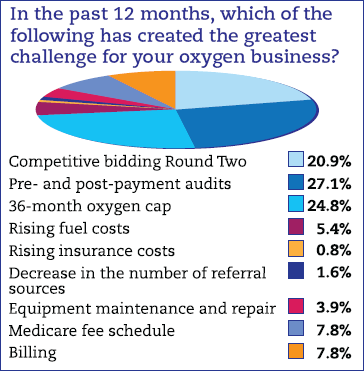
Medicare funding cuts have caused some big challenges for oxygen businesses. Just over 30 percent of respondents said their biggest challenge from Medicare funding cuts was delivering equipment/oxygen cylinders. Respondents also named maintaining customer service (29.7 percent) and maintaining respiratory therapist service (17.2 percent) as major challenges to their oxygen business.
Treatment
When asked what percentage of their client base has COPD, 40.5 percent of respondents reported that 51 percent to 75 percent of their client base has COPD, while 20.3 percent said more than 76 percent; 4.6 percent of respondents said less than 10 percent of their client base has COPD.
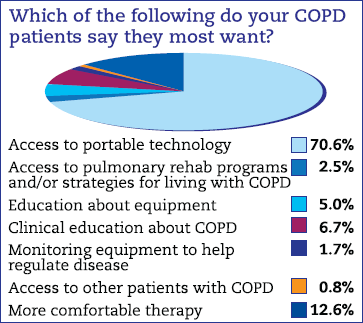
According to respondents, 70.6 percent of their COPD patients said they want access to portable technology, 12.6 percent asked for more comfortable therapy and 5 percent wanted education about equipment. When it comes to having a choice regarding oxygen devices, 57.4 percent of respondents said their patients prefer portable oxygen concentrators, and 13.9 percent said their patients prefer portable oxygen cylinder with a conserving device. Based on their patient preference for oxygen devices, 55.6 percent of respondents said patients’ most important oxygen device feature is weight (55.6 percent).
- 53.2 percent of respondents said ease of use was important.
- 47.6 percent said portability was important.
- 40.2 percent said energy efficiency is somewhat important.
This article originally appeared in the Respiratory & Sleep Management August 2013 issue of HME Business.